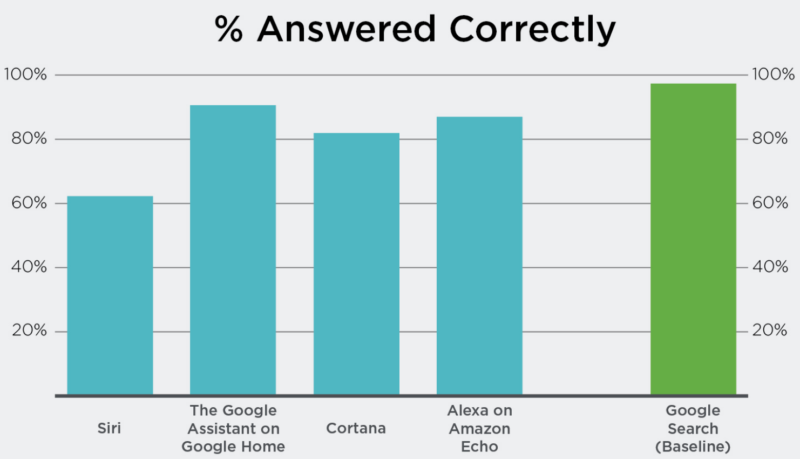Voice search is changing the way how customers look for products and services as they switched from desktops to mobile devices. Technology giants like Google and Apple are continuously revealing new features to improve the capabilities of virtual assistance, and focusing on strategies to make customers trust their brands, thanks to artificial intelligence. Voice interference technologies like Siri, Alexa, Cortana, and Google voice search are smarter and quicker to customers’ queries when asked on voice search.
Raise of Voice Search
In the last decade, the use of voice search has increased exponentially and is predicted for further growth in the upcoming years. Voice searches are not just specialized devices that offer some selected capabilities; these are digital assistance systems that are designed with artificial intelligence in all contemporary smartphones. Hence, the goal of providing customers with digital assistance in their pocket is being achieved.
Researches prove that 58% of consumers use voice search to find local business information within the last year. Also, According to OC&C Strategy Consultants, voice commerce sales are expected to reach $40 billion by 2022, and in the same year, 50% of consumers are expected to use voice shopping as well.
Australian Masters found that 25% of people used voice assistants for local shopping in last 2 years. While, According to Alpine.AI, the frequency of voice searches was expected to be in the realm of 1 billion a month In January 2018. Moreover, marketers are now keen towards the use of voice search to get to their customers. Although it is an alarming sign that 62% of them are still not paying much attention to the trend. Hence, the best way to get a competitive edge is to start preparing as soon as possible. Let us tell you how!
7 tips to Optimize your e-Commerce Website for Voice Search
1. Be a Google “Zero Hero”
For top-level awareness of your business, focus on your content. Write a useful FAQ page along with a short introduction for Position Zero. Because now, position zero is essential than anything else. Place yourself in the coveted spot to let Google rank you number one. Many e-commerce has extensively experimented with this. Hence there is no blueprint for success. Still, look for a rare searchable content and optimize your product with correct content marketing workflow.
2. Understand the difference in Speak-search and Type-search
To get the understanding of voice search, you need to take a philosophical shift in content creation. In the e-commerce world, you need to categorize your product with voice activation. Start treating your search strategy like a conversation. It requires a behavioral shift to interact with search engines or voice devices.
People are making conversation with these devices as if they as humans. This means rather than searching for “weather in Istanbul,” they ask, “Siri, what will be weather be like in Istanbul on Tuesday?” and the devise is designed to answer accurately.

If your e-commerce website is not optimized for this already, design your content as a searchable conversation with your customer because in the world of voice search, it is merely mastering the art of answering a predictable question. There is always a linguistic pattern, so apply it to the queries. Also, use long tail keywords to tackle that issue. Get experimental to strike a conversational tone in your content, and it will benefit you in the future.
3. Answer Questions Concisely
The strategy of keyword research in voice search focuses on answering the question. As you know that your potential prospect is not going to type: “venue for a winter wedding in London”. They are going to ask: “where can I find the right venue to plan a winter wedding in London?” Hence, your job is to respond to them by focusing on relevant words and expected queries. Trigger words are vital in voice searches. Keyword focus may not work here alone. You need to structure your content accordingly to get an edge over your competitor.
4. Choose Semantic Strategy over Keyword Strategy
Search engines are attempting to respond to queries just like humans. They understand their needs and customize their responses accordingly. The outcomes are more like conversations than typical robot metrics. They are able to do so by programming their algorithms to match the concept into their data.
When it comes to a semantic strategy, don’t rely on exact words in searches. Use the whole possible context of searcher’s queries. The most important implication is to provide valuable content to answer the question being asked, instead of configuring keywords in the content.
Blend different terminologies to make a variable set of phrases and keywords that covers all the genuinely relevant data of questions naturally.
5. Know Your Prospect
“Your customer is your boss who can fire your whole workforce anytime by selecting your competitor if mishandled.” says Jessica Paterson, Customer service manager at Crowd Writer.
As we know that voice search is all about the conversation. For this, you should know who is on the other side of the line to respond well. Understanding this approach, you may need to follow one-on-one marketing to get your customer to yourself. Detailed customer research is paramount. Therefore, defining your targeted customers and incorporating their purchase journey into your marketing strategy will help you to get their pain points and help you to offer them a solution that they embrace.

Hence, one thing that is common to every voice searcher is they are on the move. They talk to a digital assistant on the go busy. Accordingly, optimize your e-commerce site for responsive methodology.
6. Site Navigation for User Experience
There is a variety of patterns that a user follows for voice search. Consider taking the behavior of voice searches into account to plan a perfect user journey. Many e-commerce entrepreneurs are aware of abandoned carts and the constant battle of friction in the market. Still, they let the user enjoy the journey of voice search on mobile devices by structuring the content to drive people beyond user experience in e-commerce marketing campaigns. We recommend you to create a Google Analytics goal to track down the behavior of your potential prospect.
7. Think Local
Mobile device searches are usually local searches. This is why voice search can be an ideal way for e-commerce business owners to make their ends meet. This can be a fantastic opportunity for them to create engaging content that caters to the local audience. Crack the local market first then scale up to go beyond borders. Bringing a regional focus on your catalog will back it up for expansion and recognition.
Takeaways
When we see ourselves in the near future, the use of speaking to a search engine seems to be more commonplace. People are already comfortable to ask their devices to call someone, play music, book an appointment, and click a picture for them.
This elementary shift in customer behavior is expected to continue with the improvement in technologies as the stakeholders are going to invest more capital in the development of these devices.
So, get ready to optimize your e-commerce website for voice search to reserve your place in the rank list.
Stella Lincoln is a software developer and professional blogger. She is working as a part-time tutor for Computer Science at AcademistHelp and also, a regular contributor on Educator House. Stella loves gadgets and owns a variety of contrivances. She trains newbies in the field of AI as well.



